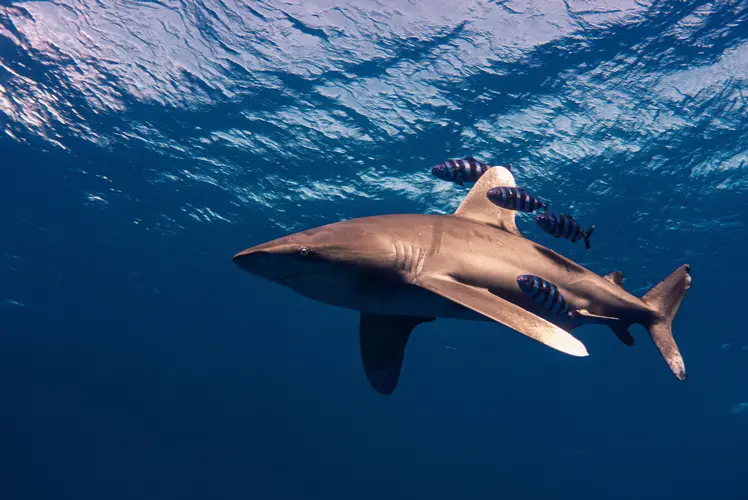
If you are looking at scuba diving the Red Sea you should include Elphinstone Reef in your itinerary, as it’s one of the best diving sites in the Red Sea, Egypt. But this is as long as you have the right level of experience and the correct scuba diving certification (see below).
But the Elphinstone Reef cannot be accessed from many land-based sites in Egypt, so how do you get to the best scuba diving in the Red Sea and Egypt?
To experience the best scuba diving in the Red Sea, Elphinstone Reef should be top of the list, which is famous for exciting shark filled drift dives. The best way to experience this top Red Sea dive site is by dive liveaboard, but you can dive Elphinstone Reef on day trips when based in Marsa Alam.
The best way to dive the Red Sea, and especially the best and more remote locations in the Red Sea, is by a scuba diving liveaboard. You can check the latest and best deals on Red Sea liveaboards using the following window:
Before you read on, you may like to take a watch of both the videos on this article about what fish eat sharks. You may be as surprised as I was when you see what happens! What fish can eat sharks?
Elphinstone Reef diving (Sha’ab Abu Hamra)
Elphinstone Reef, which is known locally as Sha’ab Abu Hamra, is one of the world’s most exciting dive sites. Every time I’ve scuba dived the Red Sea by liveaboard, I’ve always dived Elphinstone Reef. In fact, I’d probably go as far as to say it’s my favourite dive site of the Red Sea, and even better than scuba diving the Brothers for me.
It’s my favourite dive site because I love to scuba dive with sharks, and every time I’ve dived Elphinstone Reef, I’ve always seen sharks.
I’ve not dived Elphinstone Reef from Marsa Alam, but always dived from a liveaboard. I prefer liveaboard diving, as you get to dive early in the morning before breakfast, when there seems to be a better chance of seeing sharks.
Elphinstone Reef is known for its sharks, and if you’re lucky you’ll get to meet an Oceanic Whitetip Shark. Elphinstone is one of only a handful of places on Earth where you get the chance to scuba dive with Oceanic Whitetip sharks (Carcharhinus longimanus).
But you may also be lucky to see hammerhead sharks, whitetip and grey reef sharks, thresher sharks and even the occasional tiger sharks on the reef.
Be aware that if you are lucky enough to experience Oceanic Whitetip sharks, they can be extremely inquisitive around scuba divers, especially as you near the surface and you’re mid-water. Caution is recommended when Oceanic Whitetips are around and these sharks are close-by, always remain vertical in the water, as you are more of a target when you’re horizontal. Keep your eyes on the sharks at all times.
You may like to read this article and watch the video about the Brothers shark attack. Discover how the shark attack could have been avoided if the diver had followed the four rules of safe diving with sharks.
I’ll let this video do the talking, which is Elphinstone dived from the MY Thunderbird:
Liveaboard with Deep Blue Cruises, M/Y Thunderbird. 3.01.2018 – „Sha`ab Abu Hamra“ Elphinstone Reef. The Elphinstone Reef is also famous for being one of the few places on Earth where you can dive with the Oceanic Whitetip Shark as well as Harmmerhead Sharks. The best chances to spot an Oceanic Whitetip Shark (Longimanus) are from October to December. Manta Rays (mainly from May to August), Dolphins and Tiger Sharks can also sometimes be spotted. In addition to these giants, there are also plenty of pelagic fishes like trevallies, Barracudas and Tunas.
Who can scuba dive Elphinstone Reef?
To be able to dive Elphinstone Reef you need to be an Advanced Open Water Diver with PADI or an equivalent dive certification, and have at least 50 logged dives. You need this level of scuba diving experience due to the strong currents and drift diving you experience on the reef.
If you are wondering why you need this level of experience, I recommend you read this article, which is about how to deal with a down current and not panic. But if you want to know what happened to me on Elphinstone Reef in a strong down current, please jump straight to this section of the article: What would you do in this down current situation?
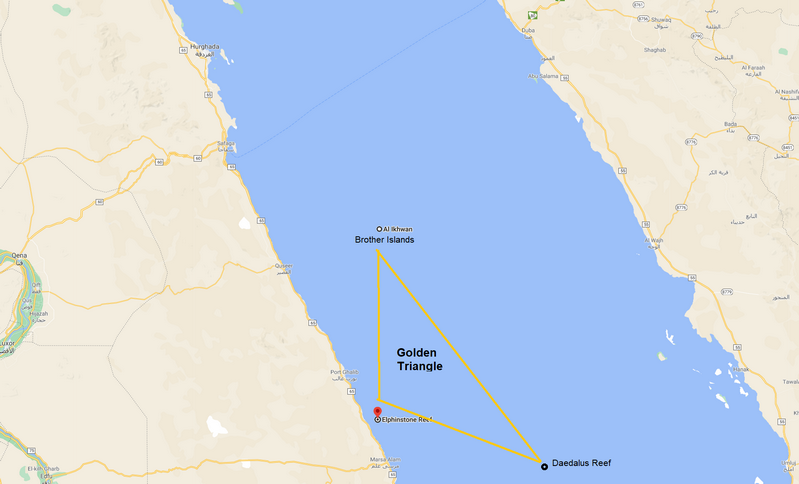
Where is Elphinstone Reef?
Elphinstone Reef is in the Red Sea, Egypt and about 6.5 miles (10.5km) offshore from Marsa Alam. One way to dive the Elphinstone Reef from a land-based location is from Marsa Alam on a day trip. But if you would like to dive Elphinstone from Hurghada you are best to dive from a liveaboard.
In my opinion a dive liveaboard is a far better way to experience this best Red Sea dive site.
If you would like to know which liveaboards visit Elphinstone Reef, you find this out from this very handy Red Sea liveaboard dive boat table.
Diving Elphinstone Reef from a dive liveaboard is also recommended as the seas can get choppy, especially when it gets very windy.
You can also search the best Red Sea Liveaboards in the table below:
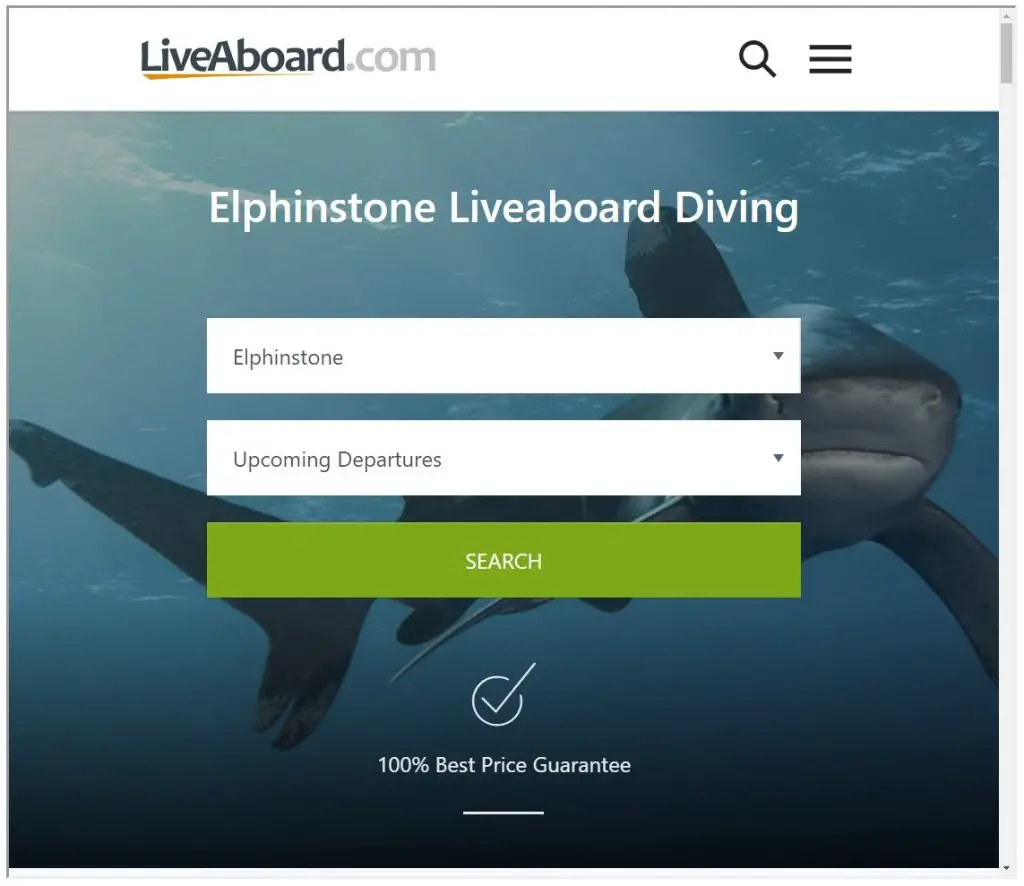
Table of liveaboard diving in the Red Sea
This list of Red Sea liveaboards is in descending customer rating order, followed by Scuba Diving Luxury Rating (SDE Lux Rating, see below), so the liveaboards with the highest customer rating and the best SDE lux rating will be at the top of the list. If you want to change the list order, use the “Sort by” dropdown below.
| Discover Liveaboard | Customer Rating | SDE Lux Rating % | Flexible Booking | Dive Courses | Dietary Requirements | Nitrox | Gear Rental | |
|---|---|---|---|---|---|---|---|---|
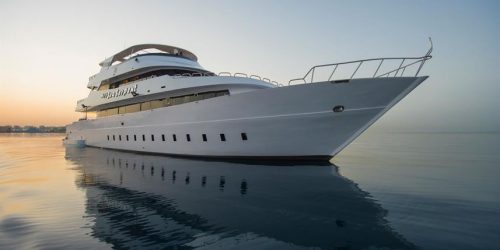 |
Review: MY Sea Serpent; Book: MY Sea Serpent | 8.9 | 65% | YES | YES | YES | YES | YES |
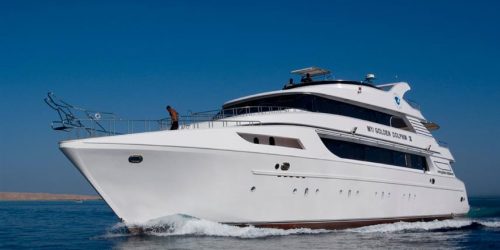 |
Review: MY Golden Dolphin III; Book: MY Golden Dolphin III | 8.9 | 62% | YES | YES | YES | YES | YES |
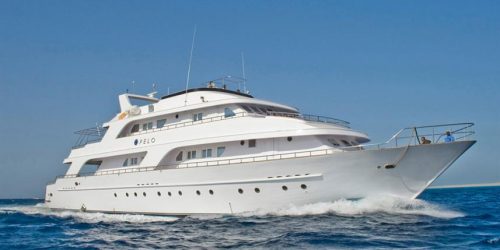 |
Review: MY Seawolf Felo; Book: MY Seawolf Felo | 8.9 | 56% | YES | YES | YES | YES | YES |
 |
Review: MY Firebird; Book: MY Firebird | 8.8 | 71% | YES | YES | YES | YES | YES |
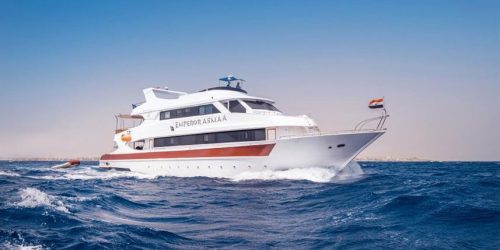 |
Review: MY Emperor Asmaa; Book: MY Emperor Asmaa | 8.8 | 71% | YES | YES | YES | YES | YES |
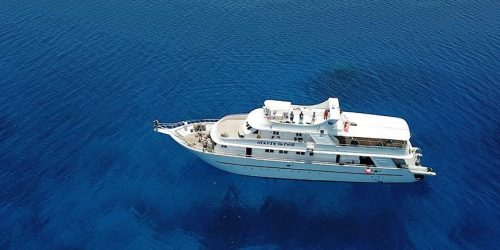 |
Review: MV Heaven Saphir; Book: MV Heaven Saphir | 8.7 | 88% | YES | YES | YES | YES | YES |
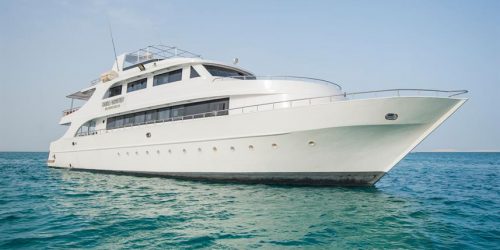 |
Review: MY Discovery II (Samira); Book: MY Discovery II (Samira) | 8.7 | 83% | NO | YES | YES | YES | YES |
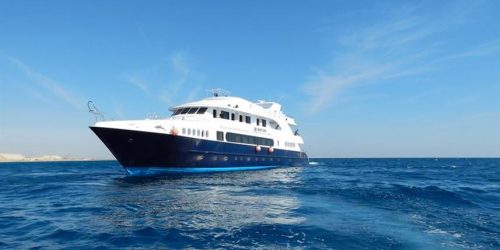 |
Review: MY JP Marine; Book: MY JP Marine | 8.7 | 81% | YES | YES | YES | YES | YES |
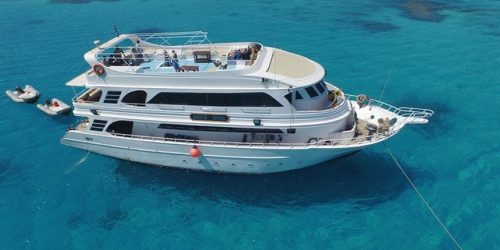 |
Review: MV South Moon; Book: MV South Moon | 8.7 | 79% | YES | YES | YES | YES | YES |
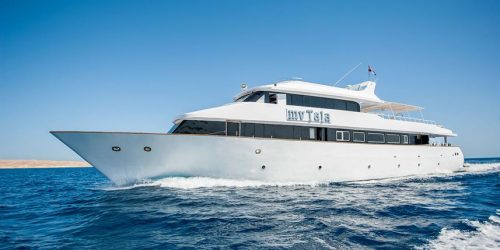 |
Review: MV Tala; Book: MV Tala | 8.7 | 71% | YES | YES | YES | YES | YES |
The Scuba Diving Earth Luxury Rating (SDE Lux Rating) is explained on each liveaboard review when you click the “Discover Liveaboard” link, and is my own Liveaboard Luxury Rating I’ve assigned to all liveaboards. Choosing between liveaboards is helped by customer scores, and if you get stuck choosing between two or three liveaboards, where each one has a high customer score out of 10, you can use the SDE Luxury Rating to help narrow down your choice.
Think about it like using Booking.com when searching for the best hotel. Booking.com also use a customer score where each customer rates hotels out of 10. This is similar to the liveaboard customer rating, which is also rated out of 10. But let’s say you only like to stay in hotels rated 8 and above on Booking.com, but you also want the hotel to have WIFI or parking, or to have a swimming pool etc. The features each hotel has is usually secondary to the score out of 10.
Another option is for you to take a look to see “what divers are saying about Elphinstone Reef diving” at the same time as reviewing the “most popular Elphinstone Reef liveaboards“.
There is a mixed bag of reviews, but here’s an example of a few of the better Elphinstone Reef reviews:
- “Very pretty coral and a curious oceanic white tip shark made for good diving“.
- “great visibility, small Longimanus“.
- “Very nice reef with resident turtle and a couple of Longimanus”.
- “Oceanic white tips and dolphins!“.
- “Tunas, barracudas, Grouper, sharks. Great diving”.
- “Nice we had very close encounter with longimanus”.
There’s a whole page of these reviews, which you can read here: Elphinstone Reef Reviews.
I have also gone through 130 scuba diver reviews of Elphinstone Reef diving and compared which months are better for sharks, manta rays and the best of the reviews that scored the diving more than 9 out of 10. It turns out that the best months for scuba diving with sharks at Elphinstone Reef are July, August and October, followed closely by September.
August and October seem to be the best months to see oceanic whitetip sharks (Longimanus) on Elphinstone Reef from the information in the table. But the months that received the best customer reviews are May and August.
My findings are displayed in the table below:
Elphinstone Reef diving reviews and shark sightings table
| Month of Elphinstone Reef Dive | Scuba Diver Ratings Over 9 out of 10 | Best Month For Shark Sightings | Best Month For Whale Shark Sightings | Best Month For Hammerhead Sightings | Best Month For Oceanic Whitetip (Longimanus) Shark Sightings | Best Month For Thresher Shark Sightings | Best Month For Manta Ray Sightings |
|---|---|---|---|---|---|---|---|
| 01. January | 0 | 0 | 0 | 0 | 0 | 0 | 0 |
| 02. February | 4 | 0 | 0 | 0 | 0 | 0 | 0 |
| 03. March | 7 | 0 | 0 | 0 | 0 | 0 | 0 |
| 04. April | 4 | 1 | 0 | 0 | 0 | 1 | 1 |
| 05. May | 10 | 3 | 0 | 2 | 1 | 0 | 0 |
| 06. June | 7 | 2 | 0 | 1 | 0 | 0 | 0 |
| 07. July | 7 | 7 | 0 | 2 | 2 | 0 | 1 |
| 08. August | 11 | 9 | 0 | 1 | 4 | 0 | 0 |
| 09. September | 2 | 4 | 1 | 0 | 2 | 0 | 0 |
| 10. October | 4 | 7 | 0 | 1 | 5 | 0 | 0 |
| 11. November | 2 | 2 | 0 | 0 | 1 | 0 | 0 |
| 12. December | 4 | 1 | 0 | 0 | 1 | 0 | 0 |
2. It should be noted that not all people who rated the diving mentioned sharks in their review, even though they may have seen sharks when they dived.
Can day boats reach Elphinstone Reef?
Day boats can reach Elphinstone reef from Marsa Alam as it’s a 6.5 mile (10.5km) trip offshore, which is by Zodiac. The trip can be a bumpy ride at times due to surface conditions. The day-trip takes around 20-30 minutes, depending on wind and sea conditions.
See for yourself in this video of an early morning dive on Elphinstone Reef on a Zodiac from Marsa Alam:
Elphinstone reef snorkeling
You can snorkel Elphinstone Reef, and the best way to do so is to snorkel in-between your dives from your liveaboard. The top of Elphinstone is very shallow and is good for snorkelling, as the colours are amazing and you’ll see loads of sea life.
What is Elphinstone Reef?
Elphinstone Reef is a subterranean mountain with steep sides dropping off to around 1,000 metres (3,280 feet) below the surface, which is rich in colourful corals and fish species and best known for sharks. The top of Elphinstone is only a few feet below the surface and presents a hazard for boats. The reef runs roughly north-south.
Elphinstone reef in detail
- Elphinstone reef is 300 metres (1,000 feet) in length.
- The reef is 30 metres (100 feet) wide at it’s widest point.
- The top of the reef is only a few feet below the surface of the water.
- There is a plateau at the north end at around 30 metres (100 feet) deep.
- The plateau at the south end of the reef is at 65 metres (213 feet).
- The Sarcophagus Archway is at the southern end at a depth of 65 metres (213 feet)*.
- The prevailing current runs north to south.
- The current can run at two knots (2.3mph) or more.
- The abysmal depths below Elphinstone is around 1,000 metres (3,280 feet).
- The north plateau is the best place to see hammerhead sharks.
- You can normally see a giant moray eel at the southern end of the reef.
* If you are a tech diver and would like to dive the Sarcophagus Archway, you can choose one of the Red Sea tech friendly liveaboards (the are 34 to choose from).
Another video of diving on Elphinstone Reef from the JP Marine Liveaboard – this video shows schooling hammerheads, an Oceanic Whitetip and a sea turtle:
What type of diving is Elphinstone Reef?
The diving on Elphinstone reef is not for the faint hearted, as the currents can be strong and the best dive is at around 30 metres deep on the north plateau. The current usually runs north to south and is often be quite strong, and can be two knots (2.3 mph)* or stronger.
If you are diving from a Red Sea liveaboard, the dive will begin from a Zodiac, as the liveaboard boat will be anchored at an anchoring point on the reef. The dive will begin with a backwards roll entry.
Always get on the early morning dive, as this is the best time to see sharks and is likely to be less busy too.
To get the best out of the dive on the north plateau you need to descend immediately on leaving the surface and find a rock to hold onto on the plateau. This will allow you to stop and look out into the blue for sharks.
Keep an eye on your dive computer to avoid going into decompression dive time. But also keep an another eye on your air consumption, as you want to keep enough air to finish the dive along the east or west side of the reef.
When the time is right, let go of your hold on the rock and the current will carry you towards the reef. You can then choose to dive along the east or west side of the reef, whilst gradually ascending towards the surface.
Make sure to keep looking out into the blue as you drift along the face of the reef, as you may be lucky to see more sharks.
Don’t forget to do your safety stop at 5-6 metres (15-20 feet) before ascending to the surface. Then make sure you swim back to the right liveaboard dive boat.
* You may not think that 2 knots or 2.3mph is fast if you’ve not experienced drift dives in this current, but when water is moving at this speed you would soon tire if you attempted to swim against it.
Scuba diving skills needed for scuba diving Elphinstone Reef
When scuba diving Elphinstone Reef, you will need the following experience and skills:
- PADI Advanced Open Water Diver or equivalent.
- 50+ logged dives.
- Drift diving training and experience.
- Good buoyancy control skills, as you’ll be wall diving over an abyss.
- Diver certification that allows you to dive to 30 metres (99 feet) or more.
- Experience of diving from a Zodiac boat will help, even if you are on a liveaboard dive boat, as the Zodiac will drop divers into the water.
- Being able to remain calm when scuba diving with sharks nearby, especially with the highly inquisitive Oceanic Whitetips*.
* Oceanic Whitetip Shark – Close Encounter with Divers – Elphinstone Red Sea Egypt:
On our safety stop, an adult oceanic whitetip shark came out of the blue and started circling us. I’ve dived with these sharks a number of times in the past, and have never seen one so interested in a diver before. The dive leader (Farag) dived at Elphinstone over 200 times and said one had never been so close, he was gently trying to fin the nose of the shark to get it to go away, but it kept on pursuing him.
To read more about oceanic whitetip sharks and how to stay safe when diving with them, please take a read of this article: Elphinstone Reef Shark Attack: Close Up Oceanic Whitetip Shark. When reading this article, please understand it’s not meant to put you off from scuba diving the Red Sea and Elphinstone Reef, it’s purpose is to help you understand these wild creatures and how to stay safe around them.
When is the best time to dive Elphinstone?
You can dive Elphinstone all year round, but the following is worth noting:
- Late summer to early autumn have the warmest sea temperatures of around 29°C (84°F).
- Waters are coldest in March time at around 22°C (71.6°F).
- Peak diving season is August when Elphinstone can get very crowded with liveaboard dive boats.
- Sharks are present year-round.
- October to December are the best months to see Oceanic Whitetips.
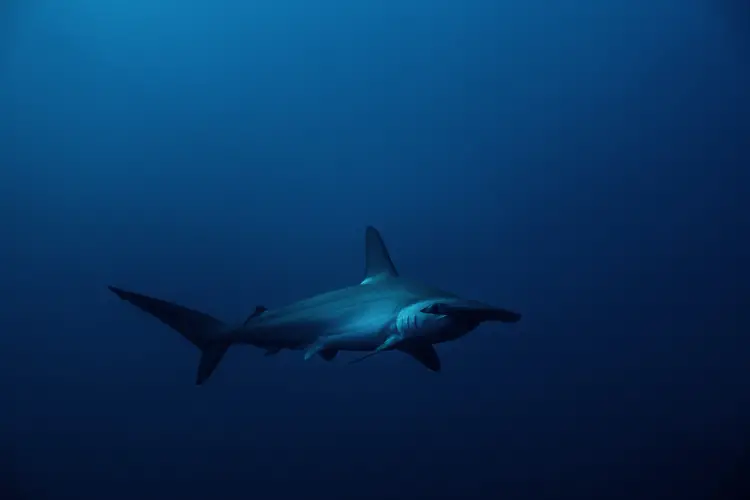
What will you see diving Elphinstone Reef?
- Hammerhead sharks, best seen off the northern plateau.
- Oceanic Whitetips.
- Turtles.
- Shoals of barracuda.
- Numerous reef fish.
- Moray eels.
- Colourful reefs.
- Silky sharks.
- Thresher sharks.
- Grey reef sharks.
- Blacktip reef sharks.
- Whale sharks (if you are lucky – see below video).
Unforgettable dive that our divers have had in Elphinstone, one of world’s top dive sites. Our divers were so lucky to have a whale shark and two oceanic whitetip sharks. Thanks to Mohamed Emad for sharing his videos from his trip from Marsa Shagra.
How did Elphinstone reef get its name?
It is said that Elphinstone Reef got its name in honour of Mountstuart Elphinstone (1779-1859), who was the fourth son of Lord Elphinstone in 1830 and was named by Commander Robert Moresby.
Mountstuart Elphinstone was a Scottish statesman and was associated with the government of British India. He later became the Governor of Bombay (now Mumbai) where he is credited with the opening of several educational institutions.
Some mistakenly call Elphinstone the Elephant Stone Reef, where the Elephant Stone is a song by the Stone Roses. But there is also a band by the name of Elephant Stone too. Elphinstone reef is also sometimes mis-spelt as Elfinstone Reef too.
Seeing that you may like the idea of scuba diving with sharks, you may like to read this article about great white sharks in the Caribbean and the Gulf of Mexico.
You may be surprised by what you read, I certainly was!
This article is also interesting about a great white shark pinged near to the Maldives.
But then if you want to be really surprised, take a read of this article about a great white shark spotted by a snorkeler off the southern Great Barrier Reef. The article includes a video of the white shark concerned.
I hope you enjoyed this page about Elphinstone Reef and the best scuba diving in the Red Sea, Egypt
If you have more questions either about snorkelling or scuba diving (or specifically about Elphinstone Reef and the best scuba diving in the Red Sea, Egypt), please comment below with your questions.
Please share your experiences, plus dive sites, resorts and liveaboards you recommend. Share the time of year of your trip together with what you saw, the visibility, currents and dive operator, as this will help others who read this page.
There will also be many more pages and articles about scuba and scuba diving safety tips (and on snorkelling too) for you to read and learn about this fabulous sport.
Have fun and be safe!

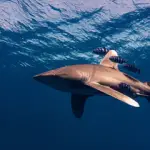
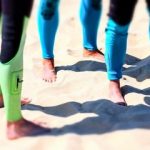
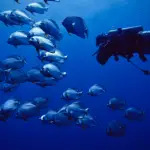
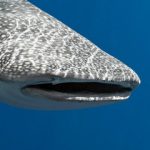
Hi there. Great article and very, very informative. Just what I need before diving there. Question: I am an AOPW with Deep, Peak Performance Specialty, Dry-Suit (during the winter season in Northern Italy) with around 164 logged dives including deep dives (in the Mediterranean Sea, Caribbean Bonaire and Maldives). During those dives I encountered on 5-6 occasions quite strong currents, especially in the Maldives in 2020, as you might imagine. The only training I do not yet have is the Drift Dive Specialty. Do you think I would be ok with my current dive experience diving Elphinstone Reef? And yes, this would be my first time diving with oceanic white-tip sharks, but I have read a lot of agonistic behavior research articles of C. longimanus. Thanks for your reply for the awesome content in your articles!
Hi Alessandro, firstly, thank you so much for your comment and positive feedback, very much appreciated.
I would say yes you should be okay, as you’ve done a reasonable amount of diving and by now you’ll be comfortable in the water and with your dive equipment.
The currents can be quite strong at the Elphinstone Reef, but if you follow the guidance given by the dive master on the dive boat you should be okay. It’s such an exciting dive site…amazing…amazing…amazing, so I really hope you enjoy.
Of all the times I dived the Elphinstone Reef, it’s been relatively straight forward to do a backward roll off the tender or Zodiac. But be prepared to dive straight down, there’s no waiting on the surface, because if you do, you will drift off the starting point on the dive site and spoilt the dive.
There was one occasion when the down-current was so strong it caught us all off guard and we were pushed down to over 60 metres, which was a bit of a worry…I link to this story above in the article…this is not said to worry you, but to be prepared as this could happen but is unlikely. Read my tips on this, as these would come in handy if that were to happen to you.
The entry for diving on the Elphinstone Reef is possibly the trickiest part of the dive, with the aim of getting down to the plateau at around 30 metres, but not that difficult really, as long as you empty your BCD of air whilst on the Zodiac, if you are good at finning and if you focus on diving straight down from the surface to the plateau (don’t hang around basically).
The aim is to find a rocky outcrop to hold onto so you can watch the pelagics and sharks (like hammerhead sharks and thresher sharks…how exciting!!), before peeling off and letting the current take you along either side of the reef, which is a pleasant gentle drift dive, which is very easy and you should not find this a problem at all.
As you drift away from the plateau and along the side of the reef, you will gradually ascend to a shallower depth to extend your dive time and to gradually decompress having been at 30-odd metres enjoying the sharks, hopefully 🙂
Please let me know if you book, but also please share your story with how you got on…I would love to share your story and pics on my blog when you return…and if you get any good videos of sharks and other stuff, even better 🙂
Take care and happy diving the Red Sea! Cheers, Russell